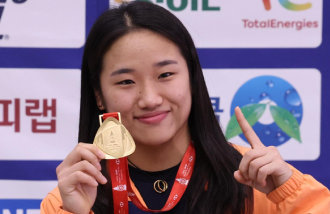S. Korea can have future when its people embrace immigrants
S. Korea can have future when its people embrace immigrants
Posted January. 19, 2022 07:47,
Updated January. 19, 2022 07:47
Adilbek, 16 years old, is from a Kazakhstan immigrant family. His family moved to Ansan, Gyeonggi Province with his mother, a third-generation Korean diaspora, in 2015. Adilbek who is interested in stock trading wants to work in the financial industry like his father who worked as an analyst at a securities firm in Kazakhstan.
According to the South Korean Ministry of Education, the number of students with an immigrant background, such as Adilbek, reached 160,056 in 2021 or three percent of the total. It is 16 times higher than 15 years ago. As the share of foreigners living in the country stands at four percent, which is just below the OECD’s five percent threshold of multi-cultural and multi-racial country, there are more students with such a background.
However, immigrant students are still struggling very much at school, according to some of them whom the Dong-A Ilbo’s Hero Contents team met. There are few schools that hired bilingual teachers or opened educational courses for them, such as Korean language courses. As a result, students of immigrant backgrounds tend to choose certain schools with international courses, such as Wongok Elementary School in Ansan, and these schools are avoided by South Korean students, a vicious cycle is created where immigrant students lose opportunities to get assimilated into Korean society.
Daycare is much worse for immigrant families. According to the U.N. Convention on the Rights of the Child, both foreigners and natives can receive public education without discrimination from elementary school. However, daycare is not included in the convention, which means foreigners who pay taxes are excluded from daycare support. In Japan, children aged three to five of foreign parents are given free education and Germany also offers daycare support and free vaccination as long as a child’s birth is registered. South Korea’s acceptance of multi-culture is very low.
It will be a shame to let immigrants who came to South Korea with hopes for a better life pass down poverty to their children due to poor daycare and education policies. Coexistence with them is essential to not only secure labor and maintain society in the era of low birth rates but also discover growth drivers from diversity. In the U.S., which is an immigrant country, 40 percent of all businesses have been founded by immigrants. In addition, 35 percent of Nobel laureates this year have immigrant backgrounds.
If South Korea were a competitive multi-cultural country, high-school student Adilbek with a dream to work in the financial industry should be given a chance to become like George Soros who was born in Hungary and became a successful investor in the U.S. Well-prepared teachers and educational programs should become bridges of opportunities that allow children of immigrant backgrounds to enjoy better lives than their parents. South Korean students will also be able to get an opportunity to learn about diverse cultures by studying together with immigrant students. South Korea, which is facing the demographic cliff, should open its future along with immigrants.





![[단독]통일교 ‘한학자 보고문건’에 ‘전재수’ 최소 7번 등장](https://dimg.donga.com/c/138/175/90/1/wps/NEWS/IMAGE/2025/12/22/133015670.1.jpg)
![[단독]“尹당선인에 용산이전 관련 한학자 의중 전해”](https://dimg.donga.com/c/138/175/90/1/wps/NEWS/IMAGE/2025/12/22/133016392.1.jpg)
